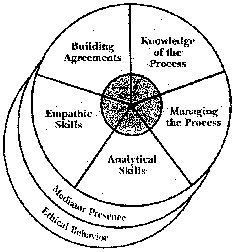Improving
Mediation Quality:
Self-Assessment and Reflection
YVONNE GRUIS
ABSTRACT
Country:
Nedherlands
Language:
English
The Wisconsin Association of Mediators (WAM) Peer support Team came up with the Self Assessment Tool for Mediators as an instrument, written down in a booklet, to help reach the goal of improving the quality of Mediators and Mediations. I am one of the co-authors.
We believe that the fundamental responsibility for maintaining and improving one's mediation skills rests with the individual. This tool assists mediators to prepare for mediation, reflect on their strategies, and review their performance.
The workshop :
The aim is to teach you how to work with the SAT. In the booklet common mediator-behaviors are listed, next to questions for reflection to become aware of the choices the mediator made and the affect of their choices on the process.
Through a short role-play I will provide feedback and encourage feedback from all the participants, using the Self-Assessment Tool for Mediators.
Our goal is to support individual knowledge, skills, and experience of adult learners, to inspire mediators to work toward higher quality services and to provide a framework for evaluation. The evaluation is a performance-based assessment for mediators. An individual as well as a group can use it for reflection on himself or on colleagues.
No specific style or professional orientation is required.

The Wisconsin Association of Mediators (WAM) Peer Support Team of the Standards and Ethics Committee came up with the Self Assessment Tool for Mediators (SATM) as an instrument, written down in a booklet, concentrated in a model that is enriched with colors to help you remind. This instrument facilitates the mediator to work on min/her self and reach the goal of high quality mediation. Yvonne Gruis is one of the co-authors and designer of the color-coded model.
The underlying idea is the believe that the fundamental responsibility for maintaining and improving one's mediation skills rests with the individual. We think that people themselves are their best critics. The SATM assists mediators to prepare for mediation, reflect on their strategies, and review their performance. Not only can it be used individually and independently, it can also be helpful when working with colleague-mediators to see where you stand and where you want to go in your profession.
The booklet
In the booklet that describes the Self-Assessment Tool for Mediators, common mediator-behaviors are listed, next to questions for reflection to become aware of the choices the mediator made and the effect of their choices on the process.
The five basis elements of mediation in the model:
¨ Knowledge of the process
¨ Managing the process
¨ Analytic skills
¨ Empathic skills
¨ Building agreements
they work in conjunction with each other during the mediation process.
As well as the foundations
¨ Mediators Presence and
¨ Ethical Behavior
which are the foundations of the mediators performance.
There also are
¨ case considerations to be examined
that can and will influence the process and thus the two foundations and
five elements.
The model
The SATM model is a dynamic thing, just like mediation. The color division
in the model will never for a second remain the same. The colors will
shift in importance and dominance, as the running mediation session requires.
If there is affinity with the meaning of color, one will probably agree
with the following chosen combination of color and mediators behavior.
The workshop
The workshop will start with a brief introduction of the trainer and
the Wisconsin Association of Mediators and its Peer support Team 1997.
We will work with one another in an interactive style.
The aim of the workshop is to be taught how to work with the Self-Assessment
Tool for Mediators, although we must keep in mind that practice makes
perfect.
During the workshop we will review selected behaviors and questions for
reflection by the short role-play demonstration.
The trainer will provide feedback and encourage feedback from all the
participants, using the Self-Assessment Tool for Mediators, as feedback
and reflection are our means to continuously improve quality mediation
service.
To obtain booklets and get further information you contact:
Wisconsin Association of Mediators
PO Box 44578 Madison Wi 53744-4578 in the USA
e-mail : cow @mailbag.com

Self-Assessment Tool for Mediators: theory, model and colors.
|
The elements
|
Chosen color
|
Meanings
|
| Knowledge of the process | Green | Demonstrate capable use of the tools of the process. Trust, safety, surrender |
| Managing the process | Red | Set a structure, manage the dispute. Leadership, dynamics |
| Analytical skills | Yellow | Clarify the issues, ask questions, listen well Bright, clarity, |
| Empathic skills | Soft Orange | Show respect and understanding Harmony, maturity |
| Building agreements | Purple Rose | Prepare the participants, generate alternatives Self-confident, creativit |
The foundations |
||
| Mediator's Presence | Blue | Be aware of your qualities and your impact Materialistic, mental, real |
| Ethical Behavior | Light Blue | Principles and values, professional guidelines Spiritual, esoteric |
| Case Considerations | Miscellaneous | Different indications Different colors |



